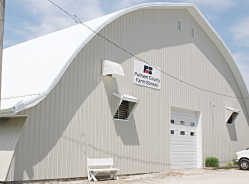1. A New York City school has adopted an all-vegetarian menu. First, many colleges adopted Meatless Monday; then, USDA MyPlate slashed protein servings in schools; and now, a school in New York City has established a
new menu for elementary students, sans meat.
A city public school, Public School 244 in Queens, is one of the first in the nation to adopt an all-vegetarian menu. The menu includes items like tofu wraps, vegetarian chili, black bean and cheddar quesadillas and roasted potatoes. The elementary school houses 400 students in pre-kindergarten through third grade.
"We think this is a really exciting development," says Ryan Huling, who coordinates PETA's work with colleges that serve vegetarian fare. "The school should be commended for providing students with low-fat, nutrient-packed brain food." Read more about this here.
According to the New York Beef Industry Council, “Are your kids getting enough nutrients to support their active body and learning needs? Are you not feeling as energetic or sharp as you should be? Do you know iron brings oxygen to our muscles as well as our brain? Iron deficiency is common among young children and women. Beef is the number-one natural food source of iron in our diet.
“Iron is an essential mineral which plays a role in a variety of body functions. Iron’s primary role is to carry oxygen and carbon dioxide within the red blood cell from one body tissue to another. Iron is also necessary for the production of energy and to support the immune system. Many foods in the diet contain iron, but this iron is not always easily absorbed by your body. Iron in meat such as beef is better absorbed and available to our bodies than plant foods.”
2. Orthorexia is on the rise. This disordered eating eliminates entire food groups such as
meat and dairy. One nutritionist warns about the dangers of excessive eating and dieting.
Michelle Roberts for WBZ-TV writes, “This is the time of year when many people are excited to get in shape and eat healthier. The problem is many people are going too far. A dangerous phenomenon called ‘Orthorexia’ is becoming more prevalent.
“Staying healthy means following a balanced diet. A growing number of people, however, are eliminating entire food groups, seeing only negative qualities in things like dairy, eggs, meats, grains, and fats. Over time, the only things left in their diet are fruits and vegetables. Taken to an extreme, it’s now treated as an eating disorder called Orthorexia.
“This is how Boston University Nutritionist Jenn Culbert defines Orthorexia: ‘What it essentially means is that someone is obsessed with eating only healthy food that they consider to be pure. Fat helps us absorb fat soluble vitamins, A, D, E, and K, and it also helps us absorb phydo-chemicals in fruits and vegetables.”
Eating disorders are certainly something to take seriously, and eliminating entire food groups can prove dangerous. After reading the comments, I have to agree that focusing on a healthy diet and active lifestyle shouldn’t be categorized as disordered eating. More and more
consumers are paying closer attention to the label, and I certainly empathize with those who abstain from certain foods because of allergies. But, for those who take diets to extremes in order to get a six-pack, this is a valid concern.
3. Women’s Health & Fitness Australia lists lean red meat as its number-one healthy food in a list of top 10 foods for active women. According to the article, “Lean red meat is an excellent source of iron, zinc, protein and vitamin B12. Iron deficiency is a very common problem for women and may lead to anemia. Symptoms include tiredness and fatigue due to a lack of oxygen in the blood and other body tissues including muscles. It is very difficult to keep active or perform optimally if you are anemic. “Female athletes are at a particularly high risk of iron deficiency irrespective of the type or intensity of exercise. While there are many physiological factors involved in female athletes’ vulnerability to iron deficiency,
low dietary intake of iron is a major factor.
“The Recommended Dietary Intake (RDI) of iron for menstruating women aged 19-50 years is 18mg/day. Iron from animal foods like red meat is more easily absorbed than iron from plant foods, with 100g of red meat containing about 3-4g of iron. Generally, the redder the meat, the higher the iron. For example, 100g of liver contains about 10g of iron, whereas 100g of pork has only 1g of iron. The Australian Dietary Guidelines recommend red meat to be eaten three to four times/week, especially for women and athletes, to maximize iron absorption. Diet tip: Combine red meat meals with dark green leafy vegetables to enhance plant
iron absorption.”
Other foods that made the list included bananas, oranges, berries, sweet potatoes, pasta, oats, natural yogurt, soybeans, and salmon.
4. Obama family enjoys steak supper every Friday night.
When she slashed protein servings in the updated USDA MyPlate food guidelines, I scratched my head, wondering how these kids would fuel up to get through advanced math classes and late-night sports practices. But, setting politics aside,
in a recent interview with CBS News, Michelle dishes on everything from her Let’s Move campaign, to gun violence, to growing food in the White House garden, to the President’s favorite meal -- beef.
“Most nights, the White House menu is driven by what comes out of the ground right there. But Friday nights, all bets are off. Friday is Steak Night.
"You know, we're not vegetarians. We love red meat," says Obama. "We generally have steak on Friday, and that's the President's favorite dinner, so Friday nights are steak nights." Like her or leave her, if she called me up to a Friday evening meal at the White House, I would be hard-pressed to turn it down. I wonder what the President’s favorite cut of beef is?
5. The Chew On This Tour is a unique, interactive road show traveling the nation to heighten awareness about one of the biggest problems facing the world today: hunger.
Tour spokesperson Bill Goldberg, former NFL lineman and champion wrestler, answers questions about world hunger and sustainable food production. A reader sent me information on this informative, educational tour, which aims to bring awareness to the one in four American children who go to bed at night hungry. The tour is full of facts to “chew on.” Here are a few to ponder this morning:
- Chew On This! About 870 million people worldwide don’t get enough food.
- Chew On This! Hunger kills more people worldwide than AIDS, malaria and tuberculosis combined.
- Chew on This! According to the United Nations, by the year 2050, the global population will be 9 billion. We will need 70% more food and 70% of that food will have to come from efficiency-enhancing technology.
- Chew on This! Less than 2% of Americans farm for a living. So many people lack knowledge about where their food comes from and how it’s produced. For more information on the tour, including facts, event photos and details for how to get involved, check out the website here.

